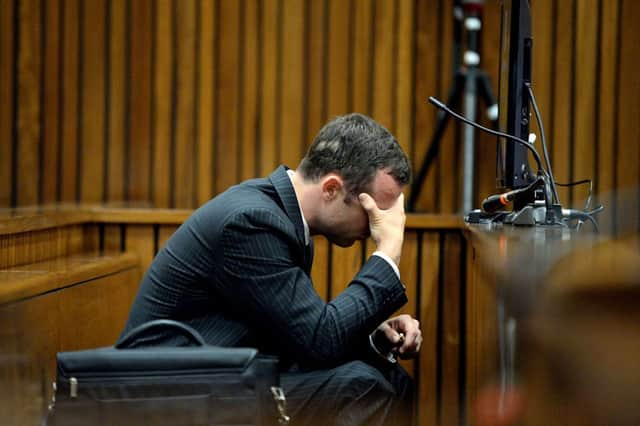Pistorius sick as court hears of Reeva injuries


The testimony of Professor Gert Saayman, the pathologist who performed the post-mortem examination on Reeva Steenkamp’s body, was not broadcast or otherwise reported live, such as on Twitter, because of its explicit content, under an order from Judge Thokozile Masipa. However, the media were allowed to report the evidence without directly quoting the witness.
The double-amputee runner, hunched over on a bench, reacted to the description of Miss Steenkamp’s wounds by vomiting and retching repeatedly, prompting Mr Masipa to briefly halt the evidence to ask chief defence lawyer Barry Roux to attend to his client. A bucket was placed at his feet.
Advertisement
Hide AdAdvertisement
Hide AdProf Saayman referred to photos that were not shown to the gallery as he described bullet wounds on Miss Steenkamp’s body, one to the right side of the head, one to the right arm and one to the right hip area.
He also described exit wounds caused by the bullets and other abrasions and discolouration of the skin, consistent with the impact of a bullet fired through a wooden object such as a door.
There was another wound on one of Miss Steenkamp’s hands.
Miss Steenkamp, a model, was wearing a pair of sports shorts and a black vest when she was shot, Prof Saayman said.
Pistorius, the first amputee to run in the Olympics, is on trial at the high court in Pretoria charged with premeditated murder over the shooting of Miss Steenkamp, 29, before dawn on 14 February, 2013.
Pistorius, 27, says the killing was accidental. He claims he thought his girlfriend was a dangerous intruder when he shot her through the door of a toilet cubicle in his home.
A security guard who said he spoke with Pistorius soon after the shooting of Miss Steenkamp was challenged by the defence yesterday about his recollection of the sequences of the events that night.
The sequence is important for the defence because, if it can prove Pistorius called security first, it could support the contention he was seeking help as quickly as possible.
The guard, Pieter Baba, had earlier told the court he called Pistorius and was told “everything is fine” on the telephone. Mr Baba said Pistorius then called him back moments later, did not speak, was crying and the second call then ended.
Advertisement
Hide AdAdvertisement
Hide AdMr Baba said he was responding to neighbours’ reports of gunshots at Pistorius’s home after 3am on Valentine’s Day last year. He drove with a fellow guard to Pistorius’s villa and called from outside the house.
Mr Baba’s statement that he called Pistorius first could back the prosecution’s case that the killing was premeditated, and that Pistorius was trying, at least initially, to conceal what he had done.
But yesterday, Mr Roux said call records showed Pistorius called security first, but could not speak because he was “indeed crying”.
“I’m the one who called him first,” Mr Baba insisted.
Before the judge’s media order, prosecutor Gerrie Nel, supported by Mr Roux, said Prof Saayman’s testimony would have an “explicitly graphic nature” and should not be shown around the world. The judge announced a ban on live audio and video broadcasting, and extended the order to live reporting on social media and blogs.
Proceedings can be partly televised and the audio can be broadcast in its entirety under a judge’s pre-trial order that sought to balance the right to a fair trial with the intense public interest in the case and the principle of open justice. Some witnesses can choose not to have their face shown on television.
Mr Masipa had extended that order, saying “private witnesses are more vulnerable than public figures” and that still photographs of witnesses who requested some discretion could not be published or disseminated for the duration of the trial, even if they were obtained from sources outside the court. This followed the publication in a South African media outlet of a photo of a witness whose image was lifted from a publicly accessible website.
The trial continues.